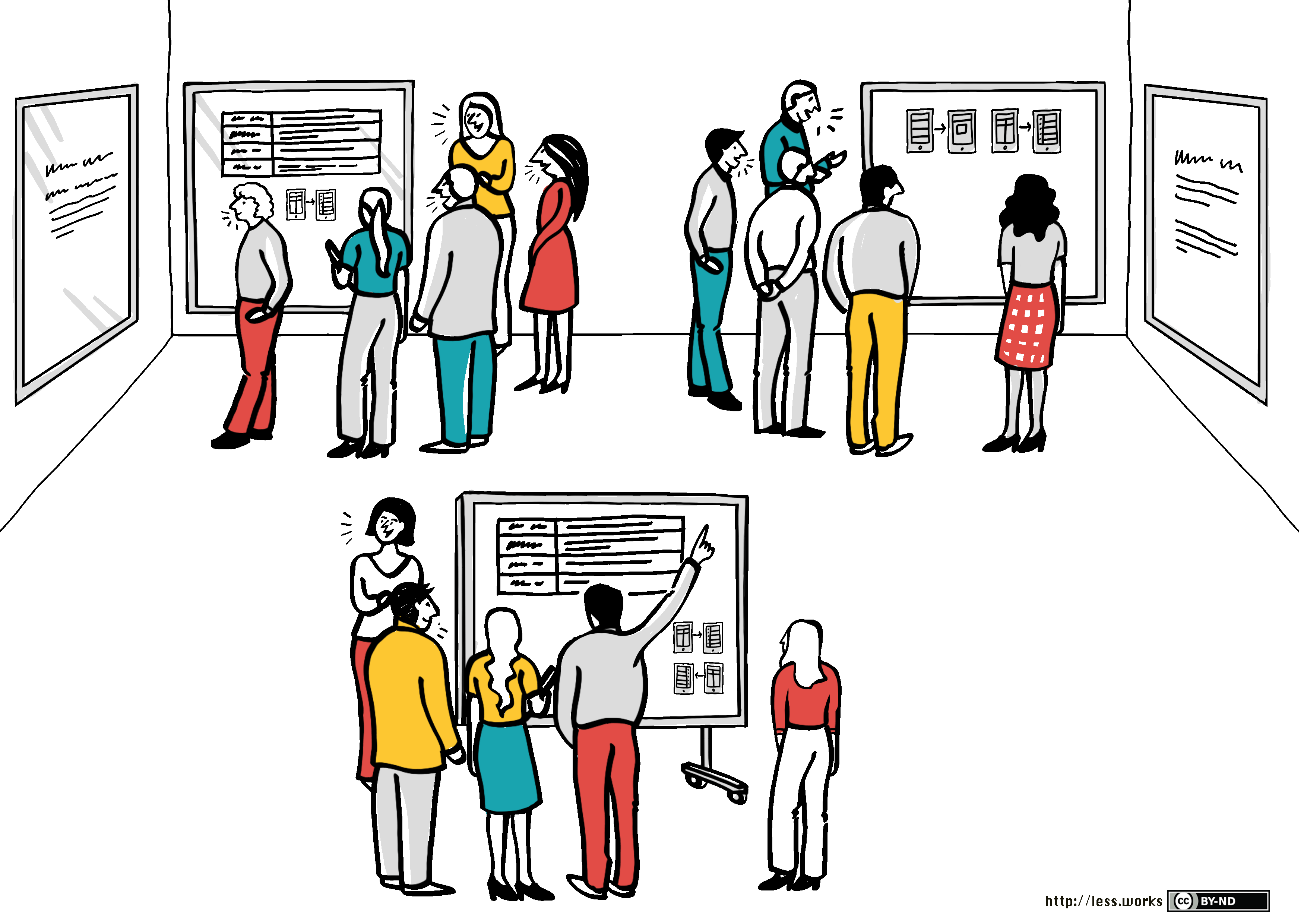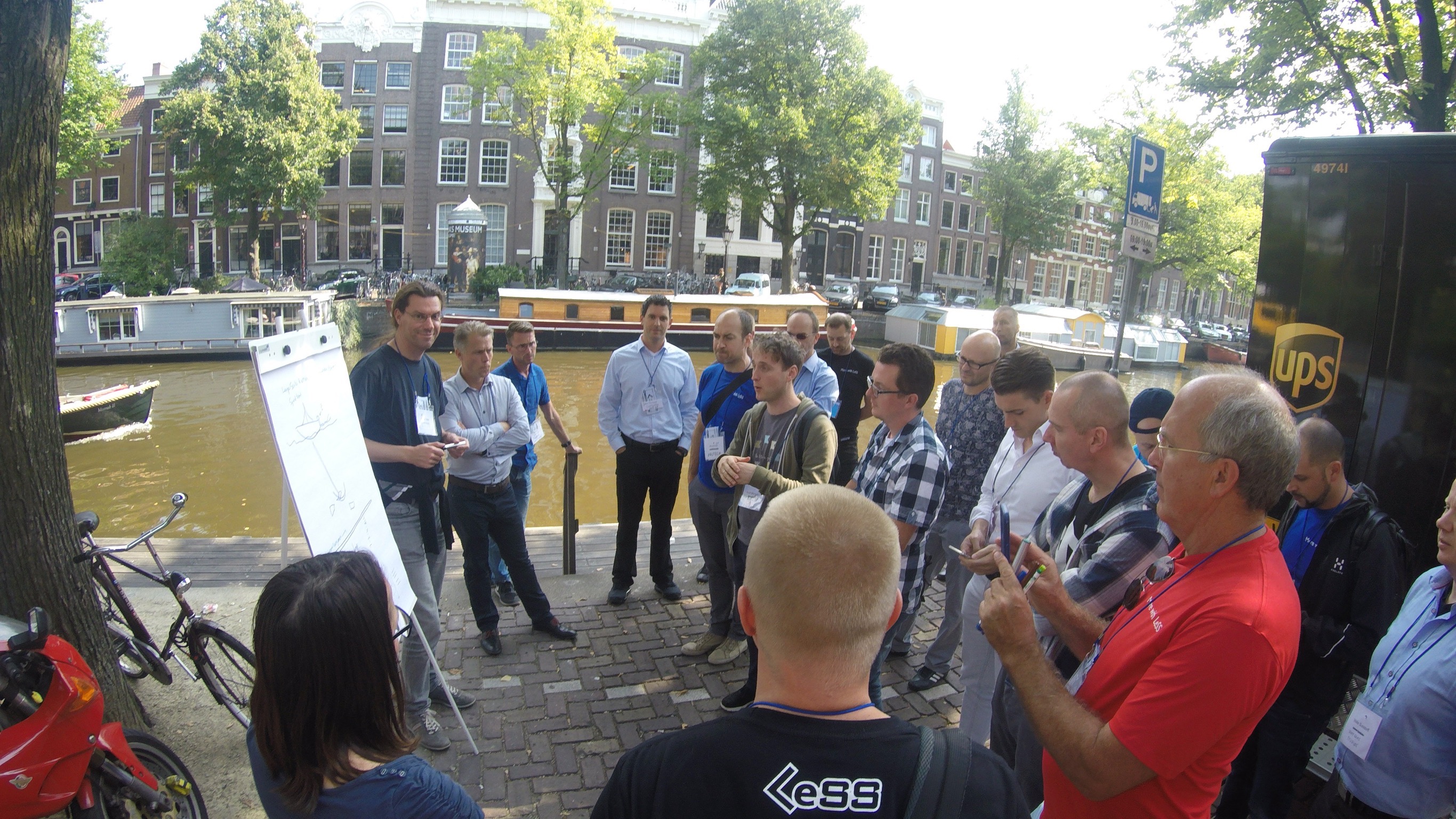LeSS Newsletter - November 2016
11.11.2016Hi,
It has only been a few months, but so many good things have happened. We'd like to share some of them.
Kindle Book
 The Kindle (and other e-versions) of the LeSS book took a bit longer to release. We wanted to fix the formatting for the book, but in the process were disappointed that the eBook was only an e-version of the printed book. We wanted to use the medium better and decided to hyperlink the whole book. This was more work than we expected, so it took a bit longer. For those waiting, we hope the result was worth waiting for.
The Kindle (and other e-versions) of the LeSS book took a bit longer to release. We wanted to fix the formatting for the book, but in the process were disappointed that the eBook was only an e-version of the printed book. We wanted to use the medium better and decided to hyperlink the whole book. This was more work than we expected, so it took a bit longer. For those waiting, we hope the result was worth waiting for.
LeSS Book Images
 When writing the LeSS book, we've spend a lot of time working with Bernie from Sketchpost on the book images. Her patience when working with us was appreciated. It couldn't have been easy to iterate over the images as many times as we wanted. We are very satisfied with the result and want to share the images with everyone so you can use them in your own training or presentations. Therefore, we've made them all available under creative commons. You can find them on the LeSS site.
When writing the LeSS book, we've spend a lot of time working with Bernie from Sketchpost on the book images. Her patience when working with us was appreciated. It couldn't have been easy to iterate over the images as many times as we wanted. We are very satisfied with the result and want to share the images with everyone so you can use them in your own training or presentations. Therefore, we've made them all available under creative commons. You can find them on the LeSS site.
LeSS Conference
 Last newsletter, we shared some info about the previous Amsterdam LeSS Conference, which was awesome. We had promised to send additional material when it is available. First, three blog posts with conference feedback:
Last newsletter, we shared some info about the previous Amsterdam LeSS Conference, which was awesome. We had promised to send additional material when it is available. First, three blog posts with conference feedback:
- Team-based Conference. A field experiement - Ahmad Fahmy
- Designing the LeSS Conference - Cesario Ramos
- Reflections on the LeSS Conference - Magnus Vestin
Also, all the presentation material is available on the LeSS Conference site.
We've not fixed the date for the next London LeSS Conference yet, but that should be soon. We'll probably put it in the next newsletter, announced seperately.
Systems Thinking
In the LeSS community and during the meet-up talks, there has been a lot of discussions and learning about Systems Thinking. During these discussions, a few useful Systems Thinking resources were shared that we'd like to share.
- Short Introduction to Systems Thinking - Peter Senge
- If Russell Ackoff Had Given a TED Talk
- Re-Thinking IT - John Seddon
- Systems Thinking in a Digital World - Peter Senge
- Targets - Vanguard Consulting
- The Beginning of System Dynamics - Jay Forrester
LeSS Case Studies - Merkur
 Wolfgang Richter published a new LeSS case study about the Austrian insurrance company Merkur. It is a thorough description of the multiple years long journey that the company took when adopting LeSS. They started experimenting with Scrum. After some success, started scaling to multiple teams inspired by LeSS. Eventually evolved further to a full LeSS adoption. We love case studies that are thorough experience reports such as these so people can learn about what and how. Much thanks to Wolfgang for writing it.
Wolfgang Richter published a new LeSS case study about the Austrian insurrance company Merkur. It is a thorough description of the multiple years long journey that the company took when adopting LeSS. They started experimenting with Scrum. After some success, started scaling to multiple teams inspired by LeSS. Eventually evolved further to a full LeSS adoption. We love case studies that are thorough experience reports such as these so people can learn about what and how. Much thanks to Wolfgang for writing it.
Other LeSS case studies can be found on the LeSS site.
Learning Resources
There has been lots of new LeSS-related articles and videos out there, and we'd like to share some of them.
- Hung Up on Scaled Agile Dependency Management - Alexey Krivitsky
- Actionable Fearless Leadership at Scrum Gathering Munich - Ari Tikka
- The Role of the Product Owner - Venky Krishnamurthy
- Scrum of Scrums is Dead - Emerging Coordination Practices at Scale - Alexey Krivitsky
- The 4 Scrum Masters We Don't Want in Our Team - Elad Sofer
- The Story of LeSS at Agile Singapore 2016 - Bas Vodde
- Sprint Review and Retrospective at the LeSS Conference - Craig Larman
- Product Backlog Refinement Simulation with User Story Mapping - Gene Gendel
- Sprint Review Turned into a Beer Fest at Xing - Alexey Krivitsky
- Rethinking the organization for agility - Talk by Jurgen de Smet at Agilie Consortium Belgium
- Collaboration at Scale: Product Backlog Refinement - Greg Hutchings, Jean-Paul Bayley, and Luke Hohmann
- Collaboration at Scale: Creating Value-Based Backlogs - Jurgen de Smet, George Schlitz, and Luke Hohman
Communities
Last newsletter we shared information about the LeSS meet-up groups in New York, Berlin, and Holland. We'll keep announcing new meet-up groups in this newsletter and started listing the communities we are aware of on the LeSS site. The new communities since last newsletter are:
- LeSS Austria Meet-up Group
- LeSS Paris Meet-up Group
- LeSS Managers community on the LeSS Slack channel
LeSS Trainer - Ahmad Fahmy

There I learned HTML and devoured everything there was to know about programming for the web. At the age of 18, a sophomore at university, I got my first full time programming job at one of the largest investment banks on the street. I went from making 7 dollars an hour in the computer lab to making what I thought was a small fortune doing the thing I was passionate about.
I jumped around different investment banks during this time. Delivery was lightening fast during this time.
After the dot.com bust, I decided to stop contracting and act like an adult and became an employee at a large investment bank. I moved “up” the corporate ladder and became a development manager. As programming began being viewed as a commodity it was seen as a career liability to be “in” the code. I continued moving up the corporate ladder and had many roles in many countries, Dev manager, project manager, program manager, enterprise architect, strategy, etc.
My company decided to “adopt” agile. The person that was to help us was Craig Larman. My first introduction to Craig was during his Certified Scrum Class.
 “And what do you do?”, he asked me during our initial introduction.
“And what do you do?”, he asked me during our initial introduction.
“I am the functional architect”, I responded.
“Interesting, that role will no longer exist here”, he responded with no emotion.
I was more intrigued than offended.
What I learned over the next three days was not as important as what I unlearned. A decade’s worth of anti patterns that I thought were sacrosanct were undone in 3 days, e.g. quality control, strong project management, strong management, etc.
I worked closely with Craig and others on the transformation of the organization and then in subsequent firms as well.
I have since led multiple large scale scrum adoptions in London, New York, India, Chicago in both large investment banks and small product companies.
What attracted me most about the approach was the simplicity of the rules of large scale scrum. The sheer simplicity of the rules coupled with the depth of the principles results in a meaningful and often painful change. I help guide organizations through the growing pains.
When the opportunity presented itself to teach others LeSS I didn't hesitate. My primary motivation is to share my experiences with others as well deepen my own understanding through teaching.
